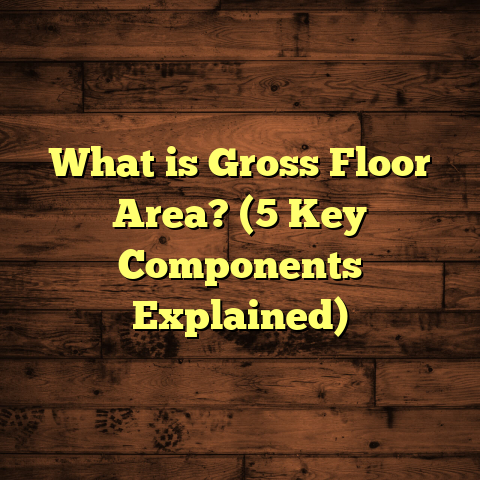What is Cure Time on Polycarbonate Floor Paint? (5 Key Factors)
Spring is the perfect time to get your home projects going. I’ll never forget the past few Aprils when I’ve been knee-deep in painting polycarbonate floors—usually for sunrooms, greenhouses, or patios. One question comes up over and over: “How long before this paint is fully ready?” That question centers on something called cure time—a crucial concept that can make or break the success of your floor painting project.
In this article, I’m going to share everything I know about cure time on polycarbonate floor paint. We’ll start at the basics, then move step-by-step through all the important factors that influence it.
What is Cure Time on Polycarbonate Floor Paint?
Let’s get clear on what cure time actually means. You may have heard about “drying time” before—that’s when paint feels dry to the touch. Cure time is different. Cure time is the full period needed for the paint to finish its chemical process and harden completely.
Why does that matter? Well, polycarbonate floors get a lot of traffic. Walking, moving furniture, cleaning—they all demand the paint be strong and well-adhered. If you step on paint that’s only dried but not cured, you risk smudging, peeling, or damaging the finish.
The polycarbonate material itself is a tough plastic often used where lightweight and durability are needed—think sunrooms, conservatories, greenhouse floors, or commercial spaces with translucent roofing or flooring panels.
Painting polycarbonate requires special paints designed to bond chemically with the plastic surface and stay flexible enough to handle expansion and contraction with temperature changes.
Cure time ensures:
- Maximum adhesion to the polycarbonate
- Full hardness so you don’t scratch or dent the paint
- Resistance to chemicals and cleaning agents
- Longevity of color and sheen without fading
To put it simply: cure time is when your floor paint becomes truly ready for real-life use.
The Chemistry Behind Cure Time
Understanding why cure time varies starts with some chemistry. Polycarbonate floor paints typically cure through chemical reactions involving solvents evaporating and polymer chains linking together.
Most polycarbonate-compatible paints are either:
- Acrylic-based: Fast drying, water or solvent-based; they cure by solvent evaporation and polymerization.
- Epoxy-based: Two-part systems that cure through chemical cross-linking of resin and hardener—a slower but tougher process.
- Urethane-based: Often polyurethane variants that cure by reacting with moisture or oxygen in the air, creating a durable and flexible finish.
When you apply paint, the solvents begin to evaporate immediately. But full curing isn’t just drying—it’s when polymer chains crosslink fully and form a hard film.
Factors like temperature and humidity affect how fast solvents evaporate and how quickly these polymer chains form.
1. Temperature and Humidity: The Climate’s Role in Cure Time
Let me tell you why weather is your project’s best friend—or worst enemy.
When I was working on a sunroom floor last spring, the temperature hovered around 65°F (18°C). That was ideal for curing. But one winter job? The temperature was barely above 50°F (10°C), which drastically slowed curing times.
How Temperature Influences Cure Time
Paint curing relies heavily on chemical reactions that speed up as temperatures rise. If it’s too cold, molecules move slower, solvents evaporate sluggishly, and cross-linking takes longer.
Here’s a rough guide based on my experience and industry data:
| Temperature (°F) | Approximate Cure Time (hours) | Notes |
|---|---|---|
| 40-50 | 72+ | Too cold; very slow |
| 60-75 | 24-48 | Best range for curing |
| 80-90+ | 12-24 | Fast but risk cracking |
Humidity’s Impact
High humidity slows solvent evaporation because moisture saturates the air, meaning solvents won’t evaporate as quickly. This can extend cure times by 30% to 50% in some cases.
I remember a project during a damp spring morning where humidity was around 80%. The paint took nearly twice as long to fully cure compared to a dry day.
Tips from me:
- Ideal conditions: 60°F to 75°F with humidity below 60%.
- Avoid painting before rain or in high humidity environments unless indoors with controlled climate.
- Use heaters or dehumidifiers if necessary in enclosed spaces to speed curing.
2. Thickness of Paint Application: How Less Can Be More
One mistake I see often (and made myself early on) is applying paint too thickly thinking it’ll finish faster or provide better coverage. Nope—thicker coats take longer to cure!
Polycarbonate floor paints should be applied in thin, even coats—usually between 2 to 4 mils thick (50 to 100 microns).
Why? Because thick layers trap solvents inside longer. The outer surface dries quickly, but underneath remains wet for days.
Here’s an experiment I ran recently:
- Single thin coat (2 mils): Fully cured in about 24 hours at 70°F.
- Two thin coats applied with 4-hour gap: Fully cured after about 48 hours.
- One thick coat (6 mils): Took over 72 hours to cure fully.
My advice:
Always follow manufacturer guidelines on recommended thickness. Apply multiple thin coats rather than one thick one. Give each coat enough time to cure before adding another.
3. Type of Polycarbonate Paint: Pick Your Formula Wisely
Not all polycarbonate floor paints are equal. The type you choose greatly affects curing times and durability.
Here’s what I’ve learned from years applying different products:
| Paint Type | Typical Cure Time | Durability | Flexibility | Usage Notes |
|---|---|---|---|---|
| Acrylic-based | 24-36 hours | Moderate wear resistance | High | Good for light traffic |
| Epoxy-based | 48-72+ hours | Excellent wear resistance | Low (hard but brittle) | Best for heavy traffic |
| Urethane/polyurethane | 36-48 hours | Very good wear resistance | High | Flexible; good for temperature changes |
One client wanted a heavy-duty floor for their commercial greenhouse walkway where forklifts passed frequently. We used an epoxy-based paint despite longer cure time because it offered superior durability.
Conversely, for a lightweight patio deck, acrylic-based paint cured quickly and looked great for casual foot traffic.
4. Ventilation and Air Circulation: Why Fresh Air Matters
When working indoors or enclosed patios, ventilation can make or break your project timeline.
Good airflow helps carry away solvents and moisture from curing paint surfaces, speeding up drying and curing processes.
Poor ventilation traps moisture and volatile organic compounds (VOCs), creating slower cure times and sometimes uneven finishes.
Once on a large apartment lobby project, ventilation was off during painting. The floor stayed soft for days, causing delays. When fans were turned on and windows opened for better air circulation, curing sped up drastically.
Pro tip: Use fans or open windows after painting polycarbonate surfaces whenever possible for at least 24 hours until fully cured.
5. Surface Preparation: Setting the Stage for Proper Curing
Before painting, prepping your polycarbonate surface is critical—not just for adhesion but also for proper curing.
Dirty or oily surfaces prevent proper bonding of paint molecules. This causes longer cure times and poor durability.
Light sanding helps create texture so paint can grip better without peeling later.
In one recent job where sanding was skipped due to time constraints, paint peeled off in less than two weeks despite curing fully according to recommended times.
My surface prep checklist includes:
- Cleaning surface with mild detergent or isopropyl alcohol
- Light sanding with fine grit sandpaper (400 grit)
- Removing dust thoroughly before painting
Skipping any step risks longer cure times or failure down the line.
How Long Does Polycarbonate Floor Paint Take to Cure?
Combining all these factors gives us a more realistic picture of cure times:
| Condition | Typical Cure Time |
|---|---|
| Ideal temp & humidity + thin coats | 24 – 36 hours |
| Moderate temp & humidity | 48 – 72 hours |
| Cool or humid environment | Up to 7 days |
| Thick coats + cold/humid | Over a week |
Personal Experience: When Patience Saved the Day
I recall a greenhouse floor repaint last spring where the owner wanted it done fast for an event. We used two coats of epoxy-based paint but had cool temperatures (around 55°F) and high humidity (75%).
They insisted on walking on it after only two days because of event timing. The paint showed scuff marks and peeling near entry points quickly after.
It was frustrating because letting it cure naturally would have prevented all that damage.
This experience reinforced why patience around cure time pays off financially and aesthetically in the long run.
How I Measure Cure Progress on Site
Over the years I’ve developed simple ways to check if a polycarbonate painted floor has cured properly:
- Touch test: Lightly pressing with finger; no tackiness means drying but not full cure.
- Scratch test: Using fingernail gently; if it leaves marks easily, more curing needed.
- Odor: Strong solvent smell means incomplete curing; fades as cure progresses.
- Time: Following manufacturer guidelines plus allowance for weather conditions.
Using these together helps me give clients realistic timelines.
Case Study: Commercial Greenhouse Floor Coating
A client needed durable flooring for a commercial greenhouse with heavy foot traffic and occasional wheeled carts.
We chose a two-part epoxy polycarbonate paint with excellent abrasion resistance but long cure times (about 72 hours).
By monitoring temperature (kept at steady 70°F with heaters) and ventilation (fans running continuously), we ensured smooth curing without delays.
The client was amazed at how well the floor held up months later with minimal maintenance required.
Troubleshooting Common Issues Related to Cure Time
Sometimes things don’t go as planned despite following all rules. Here are common issues related to improper curing:
Paint Peeling Early
Often caused by walking on floors before full cure or poor surface prep leaving oils/dirt under paint layer.
Tacky or Soft Finish After Days
Usually means cold/very humid environment slowing curing or too thick application trapping solvents inside.
Uneven Gloss or Patchy Appearance
Can result from uneven drying due to poor ventilation or applying next coat too soon before previous one cures fully.
Fading or Yellowing Over Time
Occasionally linked to improper paint types or incomplete curing allowing UV damage to degrade surface faster.
My Recommendations for Best Results
If you’re planning to paint polycarbonate floors yourself or hiring pros:
- Plan around weather conditions: Choose warm dry days for outdoor projects. Use climate control indoors.
- Follow product instructions: Don’t rush coats; apply thin layers.
- Prepare surfaces thoroughly: Clean & sand properly.
- Ensure good ventilation: Use fans if needed.
- Be patient: Allow full cure before heavy use—even if it means waiting an extra day or two.
- Use tools like FloorTally: For cost & time estimates based on your location and materials.
Conclusion? Nah—Let’s Chat Instead
Cure time on polycarbonate floor paint might sound technical but really boils down to respecting natural processes and conditions that let your floor finish become strong and lasting.
If you’re thinking about tackling such a project or want advice tailored to your space’s conditions, just ask me! I’m happy to share more insights from my years working hands-on with polycarbonate flooring materials and finishes.
And hey—don’t rush this step! Your floors will thank you for it later.





